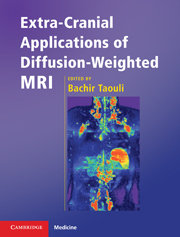Book contents
- Frontmatter
- Contents
- List of contributors
- Preface
- 1 Basic physical principles of body diffusion-weighted MRI
- 2 Diffusion-weighted MRI of the liver
- 3 Diffusion-weighted MRI of diffuse renal disease and kidney transplant
- 4 Diffusion-weighted MRI of focal renal masses
- 5 Diffusion-weighted MRI of the pancreas
- 6 Diffusion-weighted MRI of the prostate
- 7 Breast applications of diffusion-weighted MRI
- 8 Diffusion-weighted MRI of lymph nodes
- 9 Diffusion-weighted MRI of female pelvic tumors
- 10 Diffusion-weighted MRI of the bone marrow and the spine
- 11 Diffusion-weighted MRI of soft tissue tumors
- 12 Evaluation of tumor treatment response with diffusion-weighted MRI
- 13 Diffusion-weighted MRI: future directions
- Index
- References
11 - Diffusion-weighted MRI of soft tissue tumors
Published online by Cambridge University Press: 10 November 2010
- Frontmatter
- Contents
- List of contributors
- Preface
- 1 Basic physical principles of body diffusion-weighted MRI
- 2 Diffusion-weighted MRI of the liver
- 3 Diffusion-weighted MRI of diffuse renal disease and kidney transplant
- 4 Diffusion-weighted MRI of focal renal masses
- 5 Diffusion-weighted MRI of the pancreas
- 6 Diffusion-weighted MRI of the prostate
- 7 Breast applications of diffusion-weighted MRI
- 8 Diffusion-weighted MRI of lymph nodes
- 9 Diffusion-weighted MRI of female pelvic tumors
- 10 Diffusion-weighted MRI of the bone marrow and the spine
- 11 Diffusion-weighted MRI of soft tissue tumors
- 12 Evaluation of tumor treatment response with diffusion-weighted MRI
- 13 Diffusion-weighted MRI: future directions
- Index
- References
Summary
Introduction
Magnetic resonance imaging (MRI) has evolved as an important diagnostic tool for assessing soft tissue tumors due to its excellent soft tissue contrast and multiplanar reconstruction capabilities. The imaging characteristics of common benign lesions, such as lipoma and hemangioma, are often specific enough to allow a conclusive diagnosis. However, conventional MRI is limited in providing clinically satisfactory information about soft tissue tumor characterization and the presence and extent of viable tumor tissue and/or tumor necrosis.
Diffusion-weighted imaging (DWI) has been used in the assessment of tumors, particularly those of the central nervous system. Results of studies correlating apparent diffusion coefficient (ADC) values and histopathological findings have suggested that higher cellularity is associated with more restricted diffusion (i.e., lower ADC). Recently, DWI has been utilized to characterize soft tissue tumors, and is expected to provide additional useful information such as lesion characterization and the presence and extent of viable tumor tissue and/or tumor necrosis that is not available with conventional MRI. In this chapter, DWI is reviewed with regard to soft tissue tumors.
Diffusion acquisition and processing for assessment of soft tissue tumors
Several diffusion acquisition techniques have been used to investigate the diffusivity of soft tissue tumors, including spin-echo (SE), multi-shot echo-planar imaging (MS-EPI), SE single-shot echo-planar imaging (SS-EPI), and SE and line-scan sequences. Scanning times for these techniques vary from 25 s (SS-EPI) to 12 min (SE). The maximum b-values (such as 600 and 701 s/mm) used in early reports appeared too low to enable full evaluation of tumor diffusivity.
- Type
- Chapter
- Information
- Extra-Cranial Applications of Diffusion-Weighted MRI , pp. 162 - 171Publisher: Cambridge University PressPrint publication year: 2010



